(Leon © Gautier Houba)
Many serious art collectors will refer to their practice as a type of addiction. This is the same for most graffiti writers. A young man is tapping his fingers at 2 am. Sleep is out of the question. He’s gasping to write his name, his love, his discontent. He’s headed for the rooftops and the tunnels. He’s headed to your street, driven by the type of passion that leads to public sex; the type of adrenaline an athlete thrives on; the type of risk a mother might not want her child to take, and the same one that once taken might make her children fall in love. It’s a love that could land you in jail. Street art is more considered, more concerned with collectivity. It won’t kill you. It’s what happens after the orgy, when the boy scouts and the bankers ride skateboards, smoke weed and join “social events” like Occupy Brussels. It means people are having fun and acting out. In this show, politics are confined to actions whose results are often as absurd as talking about this at all.
If we’re up on the roof or back in the tunnel with Leon, if we’re talking about commissions or illicit actions, the writing on the wall says as much about the city’s current personality and the willingness of residents and passers-by to influence it’s future, as the architecture does it’s history. Let’s keep walking. There’s a lot of glorious trash to read.
1. OLD SOCIAL NETWORKS AND NEW DEALS
We’ll start off larger than a landfill with a very active local collective’s mural on Kandelaarsstraat/rue des Chandeliers. You’ll find FARM PROD works (signed and unsigned) around the city. A changing crew with a solid core, they constantly experiment with a diversity of people and approaches, exhibiting an interest in painting out there in the world together.
Keep walking: graffiti and street art in Brussels
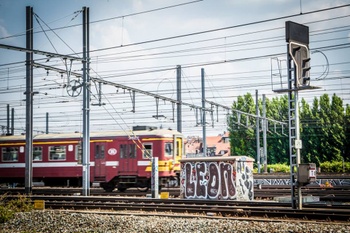
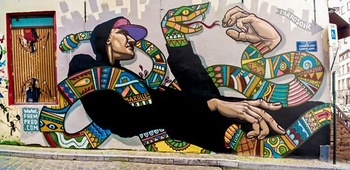
(Guitar X a Squid called Sebastian © Gautier Houba)
This exchange between Farm Prod’s GUITAR and Ghent-based artist A SQUID CALLED SEBASTIAN, reminds me that long before there was so-called social media, artists interested in (beautifying or destroying) public space, formed a real-time social network that operated on a very friendly, and often drunken, basis. The attitude is one that doesn’t take itself too seriously – which doesn’t mean these guys don’t get their shirts wet – and focuses on the art of creating collective good times and positive connections: ephemeral moments before eternal masterpieces.
2. HYPERREALISM AND GOOD NEIGHBOURS
In 2006, American LOGAN HICKS collaborated with Ephameron from Antwerp and Lucy Mclauchlan from Bristol to paint a garage and this adjacent door on Gootstraat/rue de la Gouttière. Logan recalls an 80-odd-year-old neighbour coming up to him as they worked and thanking them for getting rid of the piss and needles that formed a constant prickly river on this sidestreet for a decade.
This exchange between Farm Prod’s GUITAR and Ghent-based artist A SQUID CALLED SEBASTIAN, reminds me that long before there was so-called social media, artists interested in (beautifying or destroying) public space, formed a real-time social network that operated on a very friendly, and often drunken, basis. The attitude is one that doesn’t take itself too seriously – which doesn’t mean these guys don’t get their shirts wet – and focuses on the art of creating collective good times and positive connections: ephemeral moments before eternal masterpieces.
2. HYPERREALISM AND GOOD NEIGHBOURS
In 2006, American LOGAN HICKS collaborated with Ephameron from Antwerp and Lucy Mclauchlan from Bristol to paint a garage and this adjacent door on Gootstraat/rue de la Gouttière. Logan recalls an 80-odd-year-old neighbour coming up to him as they worked and thanking them for getting rid of the piss and needles that formed a constant prickly river on this sidestreet for a decade.
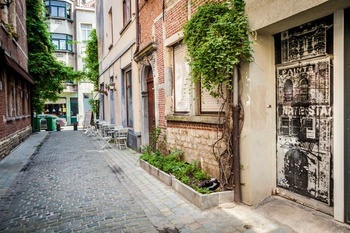
(Logan Hicks © Gautier Houba)
Street art here appeared not as vandalism, but as a way to defend against it. Regardless of the artwork, this is the common idea that makes me love that these works exist no matter how I feel about each one. Seven years later, the stencil remains. Hand-cut and spray-painted, Hicks’s art is a form of obsessive-compulsive hyperrealism that might have made Isy Brachot wet at the lips. Crude materials are applied in a refined and even gentlemanly way. It looks like an etching. Like other leaders from this scene (such as Shepard Fairey, Banksy, Influenza, ROA, or Will Barras), Logan, Lucy, and Ephameron’s entry to Brussels was the No New Enemies network and the Mr. Ego at Steenstraat 29 rue des Pierres.
3. SPEAKING WITHOUT MOVING YOUR LIPS
On the wall opposite the Guitar/a Squid called Sebastian piece, another large mural gives Brussels the blues and yellows we’ve been enjoying the last few weeks and occasionally moan about missing the rest of the year. Maybe it’s the colours, but this work pleased me before I paused to spend time reading it. PAROLE seems to consciously cross cultural lines that pile up between graffiti and street art.
Street art here appeared not as vandalism, but as a way to defend against it. Regardless of the artwork, this is the common idea that makes me love that these works exist no matter how I feel about each one. Seven years later, the stencil remains. Hand-cut and spray-painted, Hicks’s art is a form of obsessive-compulsive hyperrealism that might have made Isy Brachot wet at the lips. Crude materials are applied in a refined and even gentlemanly way. It looks like an etching. Like other leaders from this scene (such as Shepard Fairey, Banksy, Influenza, ROA, or Will Barras), Logan, Lucy, and Ephameron’s entry to Brussels was the No New Enemies network and the Mr. Ego at Steenstraat 29 rue des Pierres.
3. SPEAKING WITHOUT MOVING YOUR LIPS
On the wall opposite the Guitar/a Squid called Sebastian piece, another large mural gives Brussels the blues and yellows we’ve been enjoying the last few weeks and occasionally moan about missing the rest of the year. Maybe it’s the colours, but this work pleased me before I paused to spend time reading it. PAROLE seems to consciously cross cultural lines that pile up between graffiti and street art.
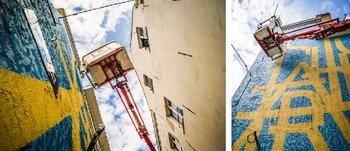
(Parole © Gautier Houba)
The painting plays with calligraphy through layers of text, testifying to informed sensibilities of design, form, and finishing in order to tell an insider’s story. Together the two murals remind me of former US president Franklin D. Roosevelt’s artistic ambitions as he brokered the New Deal. The artwork doesn’t just fill the walls, it transforms the neighbourhood: acting as a catalyst for community pride and new conversations. Both murals were created for the Kosmopolite festival, a touring street project, which Farm Prod has produced in Belgium for the last three years.
4. PENCILS AS OLD-SCHOOL PUNKS
What tool of expression is more romantic than a pencil today? When there’s no request for one single piece, no commission, no right, we are more likely to meet a beautiful vandal who runs rampant in repetition. This brings us back to addiction and desire: the need to tell a story and take a chance. In Brussels you can find a CRÉONS fix in every corner of town, each time sprayed on a different support (wall, window, van, electricity box, and so on).
The painting plays with calligraphy through layers of text, testifying to informed sensibilities of design, form, and finishing in order to tell an insider’s story. Together the two murals remind me of former US president Franklin D. Roosevelt’s artistic ambitions as he brokered the New Deal. The artwork doesn’t just fill the walls, it transforms the neighbourhood: acting as a catalyst for community pride and new conversations. Both murals were created for the Kosmopolite festival, a touring street project, which Farm Prod has produced in Belgium for the last three years.
4. PENCILS AS OLD-SCHOOL PUNKS
What tool of expression is more romantic than a pencil today? When there’s no request for one single piece, no commission, no right, we are more likely to meet a beautiful vandal who runs rampant in repetition. This brings us back to addiction and desire: the need to tell a story and take a chance. In Brussels you can find a CRÉONS fix in every corner of town, each time sprayed on a different support (wall, window, van, electricity box, and so on).
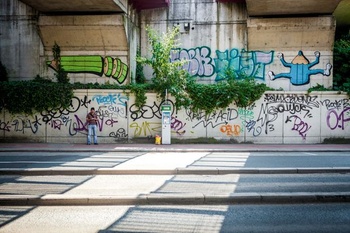
(Créons © Gautier Houba)
No two pencils are the same: angry pencil, cowboy pencil, limp pencil, happy pencils, half pencils, red, blue, green, or yellow pencils referencing the writing of what could be an emotional diary. Forget Sex and the City. Here’s some encouragement to write your own urban adventure and find a familiar face in areas you don’t frequent. These works are so playful, fun, and easy to access that I almost forget how much sweat must have gone into the rush of creating them. Whoever does this, makes it look easy and this takes skill and speed. Keep writing bud, you brighten our days. The rest of you: if you don’t see a pencil within a week of reading this, please look closer.
5. BITERS
“Biting” means stealing somebody else’s style and there’s a big difference between aping and assimilating, between being influenced and hijacking. When it comes to what you happen to see on the street, its par for course and the viewer doesn’t care about the chicken and egg debate. We could be disappointed though in the level of forward thinking employed by ADVERTISING companies that “bite” on the peer-to-peer gift economy attitude that led to the popularity of what we now call street art: so often those who make a commodity of cool, ignore how it mutates when you slice out sincerity.
No two pencils are the same: angry pencil, cowboy pencil, limp pencil, happy pencils, half pencils, red, blue, green, or yellow pencils referencing the writing of what could be an emotional diary. Forget Sex and the City. Here’s some encouragement to write your own urban adventure and find a familiar face in areas you don’t frequent. These works are so playful, fun, and easy to access that I almost forget how much sweat must have gone into the rush of creating them. Whoever does this, makes it look easy and this takes skill and speed. Keep writing bud, you brighten our days. The rest of you: if you don’t see a pencil within a week of reading this, please look closer.
5. BITERS
“Biting” means stealing somebody else’s style and there’s a big difference between aping and assimilating, between being influenced and hijacking. When it comes to what you happen to see on the street, its par for course and the viewer doesn’t care about the chicken and egg debate. We could be disappointed though in the level of forward thinking employed by ADVERTISING companies that “bite” on the peer-to-peer gift economy attitude that led to the popularity of what we now call street art: so often those who make a commodity of cool, ignore how it mutates when you slice out sincerity.
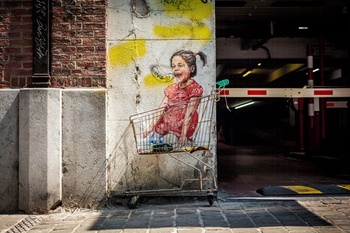
(© Gautier Houba)
This work on rue Léon Lepagestraat lacks genuineness. The perspectives are lousy. The painting is amateur and the messaging is mixed: a child in a half a shopping cart? I don’t really get it, but its cute and unexpected so a lot of folks stop and take pictures. Usually they seem to like it. As “street art” it could be great, because it might be done by a 13-year-old genius, but it’s not. It’s lousy advertising (for a car company). Besides being an incoherent campaign, the publicity invited more vandalism, is now rusted, and functions as a garbage can. Buy your car and clean up your mess? Thanks, but no thanks.
6. FIGHTERS
After that last interruption, street talk calls for a good old cock and balls joke, which is how I read IDIOT’s intervention last year. I found this action much funnier than the scaffolding that resembles a permanent installation around the building. That joke is old by now. The art involved was getting up (on top of the building) and getting up again (painting “idEAHOT” by moonlight). This was pure graffiti and there’s a second serious joke: it’s a “throw-up”.
This work on rue Léon Lepagestraat lacks genuineness. The perspectives are lousy. The painting is amateur and the messaging is mixed: a child in a half a shopping cart? I don’t really get it, but its cute and unexpected so a lot of folks stop and take pictures. Usually they seem to like it. As “street art” it could be great, because it might be done by a 13-year-old genius, but it’s not. It’s lousy advertising (for a car company). Besides being an incoherent campaign, the publicity invited more vandalism, is now rusted, and functions as a garbage can. Buy your car and clean up your mess? Thanks, but no thanks.
6. FIGHTERS
After that last interruption, street talk calls for a good old cock and balls joke, which is how I read IDIOT’s intervention last year. I found this action much funnier than the scaffolding that resembles a permanent installation around the building. That joke is old by now. The art involved was getting up (on top of the building) and getting up again (painting “idEAHOT” by moonlight). This was pure graffiti and there’s a second serious joke: it’s a “throw-up”.

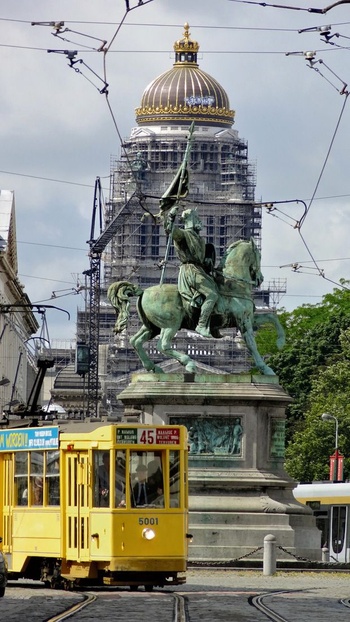
(Idiot © Yves Calomme)
Costly humour as the anti-hero was located, locked up, and fined heavily; the work was cleaned up in record time. It would be difficult to argue against this reaction, but less so to ask if public space has corporate privileges. Maybe it’s just logical: the bigger the risk, the harder the fall. Idiot climbed to the top of the “palace” and spat. Zacharevic did his piece seated as if he were in a studio. At the same time, only one of these works could be called democratic and it isn’t the pretty one in the shopping cart. That said, participants to the city’s longest running art exhibition are likely to come and go, long after work around the Justitiepaleis/Palais de Justice has been completed or perhaps begun again.
BRUSSELS'S LONGEST RUNNING ART EXHIBITION PART I
with Bonom, Invader, Influenza, Above, ROA, Chuck Hargrove, and Manu-Tention
Costly humour as the anti-hero was located, locked up, and fined heavily; the work was cleaned up in record time. It would be difficult to argue against this reaction, but less so to ask if public space has corporate privileges. Maybe it’s just logical: the bigger the risk, the harder the fall. Idiot climbed to the top of the “palace” and spat. Zacharevic did his piece seated as if he were in a studio. At the same time, only one of these works could be called democratic and it isn’t the pretty one in the shopping cart. That said, participants to the city’s longest running art exhibition are likely to come and go, long after work around the Justitiepaleis/Palais de Justice has been completed or perhaps begun again.
BRUSSELS'S LONGEST RUNNING ART EXHIBITION PART I
with Bonom, Invader, Influenza, Above, ROA, Chuck Hargrove, and Manu-Tention
Read more about: Expo
Fijn dat je wil reageren. Wie reageert, gaat akkoord met onze huisregels. Hoe reageren via Disqus? Een woordje uitleg.